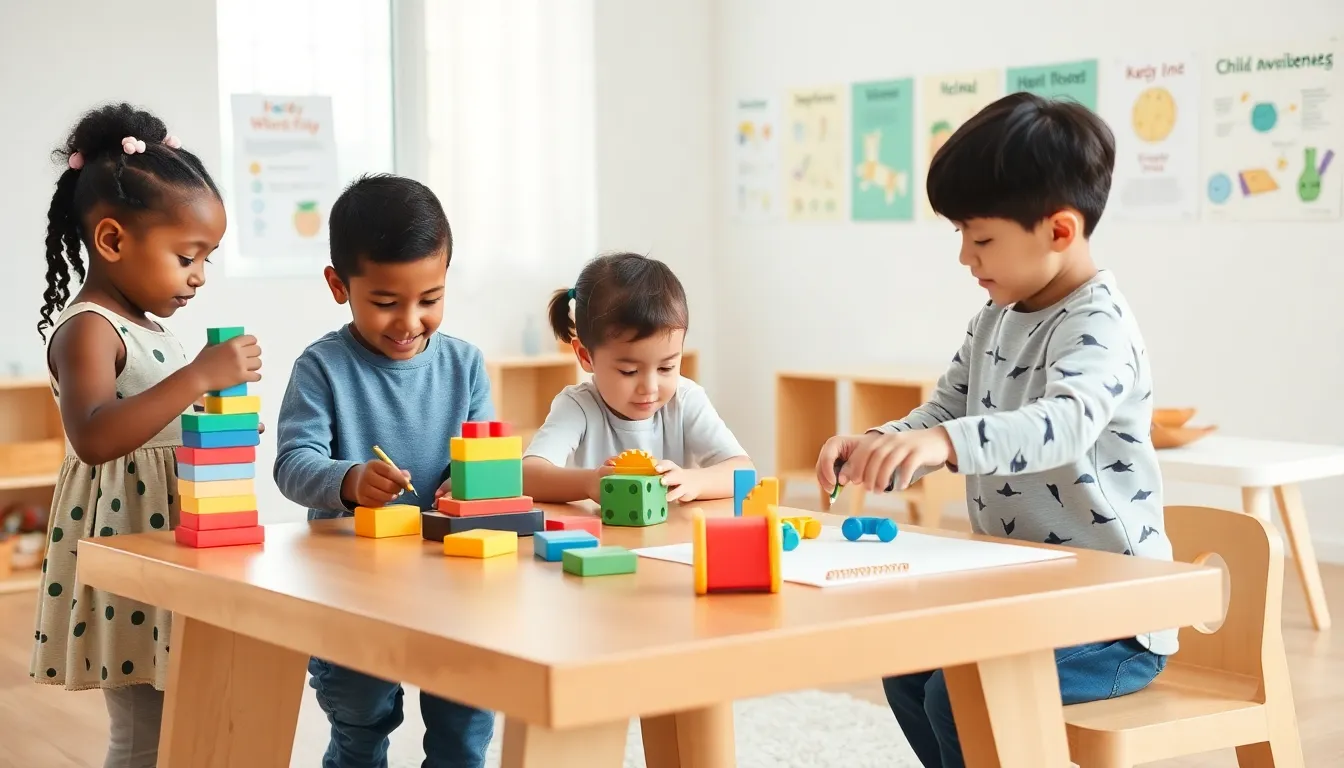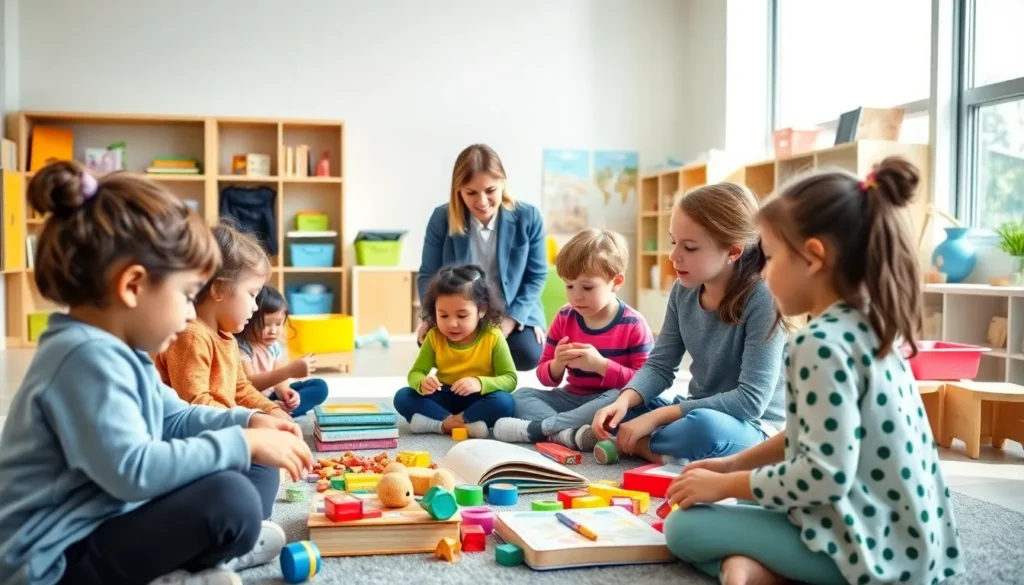Table of Contents
ToggleLet’s face it, navigating the world of child development curricula can seem as perplexing as trying to decipher a toddler’s drawing. There’s so much information swirling around that it feels like a kaleidoscope of possibilities. But fear not. By the end of this article, you’ll be equipped with the knowledge you need to create or evaluate a child development curriculum that fosters growth, creativity, and learning. So, pour yourself a cup of coffee (or perhaps a well-deserved glass of wine), and let’s unpack this critical topic together.
Understanding Child Development

To create a robust child development curriculum, one must first grasp what child development encompasses. This isn’t just about keeping kids busy with fun activities: it involves understanding the stages of emotional, social, cognitive, and physical growth.
From birth to age eight, children undergo significant changes. They evolve rapidly, exploring the world in unique ways. Each stage of development, be it sensory experiences in infancy or social interactions in preschool, demands tailored approaches. So, it’s essential for educators and caregivers to recognize these developmental milestones to effectively support children’s growth.
Also, child development theories, such as Piaget’s stages of cognitive development and Vygotsky’s social constructivism, provide crucial insights. By incorporating these theories into their curricula, educators can help children develop critical thinking and problem-solving skills. Understanding these fundamental aspects lays the groundwork for creating an impactful curriculum.
Key Principles of Effective Curriculum
Creating an effective child development curriculum isn’t just about lessons and lessons plans. It involves embracing core principles that guide instructional practices.
- Child-Centered Approach: Putting the child at the heart of the curriculum fosters a love for learning. Engaging activities tailored to individual interests ignite curiosity and encourage exploration.
- Holistic Development: Focusing on all areas of a child’s development, cognitive, emotional, social, and physical, is paramount. A well-rounded curriculum promotes balance, ensuring that children grow into well-adjusted individuals.
- Active Learning: Curiosity thrives with hands-on activities. Crafting a curriculum with plenty of opportunities for experiential learning means that children absorb information more effectively.
- Inclusive Practices: An inclusive curriculum welcomes children from diverse backgrounds and with different abilities. This not only enriches the learning experience but also promotes empathy and understanding from a young age.
By weaving these principles into the fabric of the curriculum, educators can create a learning environment that prepares children for future success.
Components of a Child Development Curriculum
Delving into the nuts and bolts, several components make up a comprehensive child development curriculum:
- Learning Objectives: Clear, specific goals that define what children should achieve at each stage of development.
- Learning Experiences: The activities and interactions that encourage exploration and understanding. These should be diverse and appealing to cater to various learning styles.
- Resources: Books, materials, technology, and tools that support learning and engagement are vital. A variety of resources helps expand children’s horizons.
- Environment: The physical space plays a crucial role. A well-organized environment that promotes safety and accessibility allows children to thrive.
- Assessment Strategies: Regular assessments help monitor progress and inform instruction. They should be both formal and informal, considering the holistic development of the child.
Each of these components interlocks to create a robust curriculum that nurtures children’s overall growth.
Age-Appropriate Learning Activities
Age-appropriate learning activities cater to the developmental stages of children. For instance:
- Infants (0-12 months): Focus on sensory exploration through touch and sound. Think textured books and rattles.
- Toddlers (1-3 years): Motor skills development through art and messy play. Finger painting? A win for toddlers.
- Preschoolers (3-5 years): Introducing basic math and literacy through stories and songs enhances cognitive skills while fostering imagination.
- Early Elementary (6-8 years): Hands-on science projects can ignite curiosity. A little garden experiment can lead to big questions.
Each activity directly aligns with the developmental benchmarks for that age group, making learning both fun and effective.
Assessment and Evaluation in Child Development
While formative assessments might seem like a chore for educators, they are essential for tracking a child’s growth. An effective assessment plan should:
- Be Developmentally Appropriate: Recognizing that children’s abilities vary greatly, it’s vital to develop assessment tools that accommodate these differences.
- Include Multiple Methods: Use a mix of observational assessments, portfolios, and standard textbook evaluations. Variety captures a fuller picture of a child’s development.
- Involve Families: Engaging family members in the assessment process fosters a more comprehensive understanding of the child’s needs and strengths.
- Focus on Growth: Rather than solely looking at outputs, evaluate progress over time. Growth is more important than perfect scores.
Using these strategies creates a supportive environment where children can thrive.
Incorporating Family and Community Involvement
Family engagement is not merely a buzzword: it’s crucial for a successful child development curriculum. When families are involved, children’s learning is enriched. Strategies to enhance family and community participation include:
- Workshops and Events: Hosting events that invite parents to participate fosters a sense of community and shared responsibility.
- Communication: Effective communication between educators and families bridges the gap. Regular newsletters or updates keep families informed and involved.
- Community Resources: Partnering with local organizations provides families with additional support. This could include counseling services, parenting classes, or local library resources.
When families and communities actively engage with the curriculum, it creates a holistic support system for each child.
Future Trends in Child Development Curriculum
What does the future hold for child development curricula? Here are a few trends shaping the landscape:
- Technology Integration: As tech-savvy generations emerge, incorporating educational technology will become essential. Interactive apps and online resources can enhance learning experiences.
- Focus on Mental Health: The importance of emotional well-being is gaining recognition. Future curricula will likely integrate mental health education and social-emotional skills training.
- Sustainability Education: Environmental awareness is crucial. Teaching children about sustainability will become part of standard practices, instilling responsibility toward the planet from a young age.
- Culturally Responsive Teaching: As classrooms become more diverse, curricula will adapt to include multiple perspectives and backgrounds, enhancing understanding and respect among peers.
Each of these trends holds the potential to transform how children learn and grow.







